中英诗歌对比赏析·中西文化差异共20页
中西诗歌文化异同 2
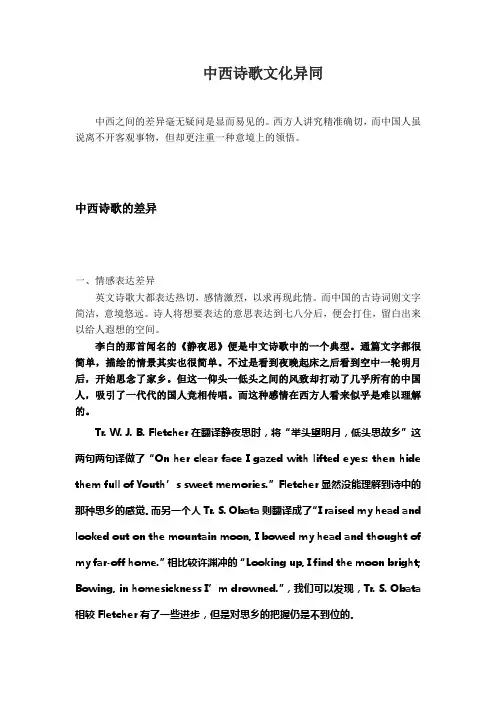
中西诗歌文化异同中西之间的差异毫无疑问是显而易见的。
西方人讲究精准确切,而中国人虽说离不开客观事物,但却更注重一种意境上的领悟。
中西诗歌的差异一、情感表达差异英文诗歌大都表达热切,感情激烈,以求再现此情。
而中国的古诗词则文字简洁,意境悠远。
诗人将想要表达的意思表达到七八分后,便会打住,留白出来以给人遐想的空间。
李白的那首闻名的《静夜思》便是中文诗歌中的一个典型。
通篇文字都很简单,描绘的情景其实也很简单。
不过是看到夜晚起床之后看到空中一轮明月后,开始思念了家乡。
但这一仰头一低头之间的风致却打动了几乎所有的中国人,吸引了一代代的国人竞相传唱。
而这种感情在西方人看来似乎是难以理解的。
Tr. W. J. B. Fletcher在翻译静夜思时,将“举头望明月,低头思故乡”这两句两句译做了“On her clear face I gazed with lifted eyes: then hide them full of Youth’s sweet memories.”Fletcher显然没能理解到诗中的那种思乡的感觉。
而另一个人Tr. S. Obata则翻译成了“I raised my head and looked out on the mountain moon, I bowed my head and thought of my far-off home.”相比较许渊冲的“Looking up, I find the moon bright; Bowing, in homesickness I’m drowned.”,我们可以发现,Tr. S. Obata相较Fletcher 有了一些进步,但是对思乡的把握仍是不到位的。
这跟中文诗歌中的意境不无关系。
在中国文化里,月往往是悲情的,不完满的。
月的形象总是跟短暂与变幻联系在一起。
睹月思乡是一种常见的情绪宣泄。
除此之外,王建曾写道,“今夜月明人尽望,不知秋思落谁家”。
中英文诗歌特色对比
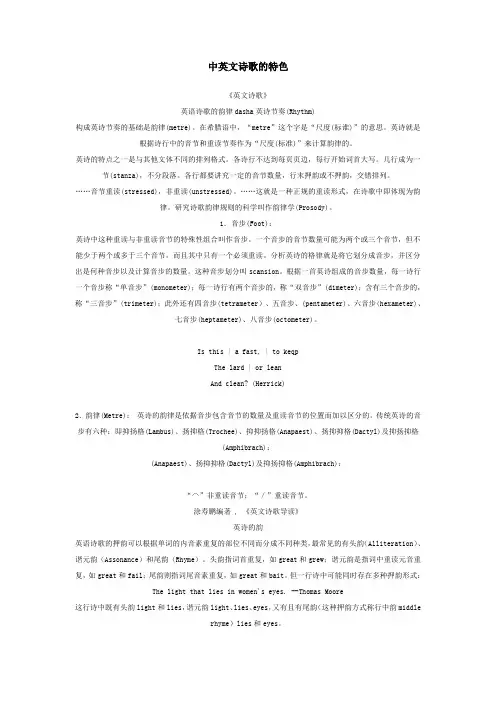
中英文诗歌的特色《英文诗歌》英语诗歌的韵律dasha英诗节奏(Rhythm)构成英诗节奏的基础是韵律(metre)。
在希腊语中,“metre”这个字是“尺度(标谁)”的意思。
英诗就是根据诗行中的音节和重读节奏作为“尺度(标准)”来计算韵律的。
英诗的特点之一是与其他文体不同的排列格式。
各诗行不达到每页页边,每行开始词首大写。
几行成为一节(stanza),不分段落。
各行都要讲究一定的音节数量,行末押韵或不押韵,交错排列。
……音节重读(stressed),非重读(unstressed)。
……这就是一种正规的重读形式,在诗歌中即体现为韵律。
研究诗歌韵律规则的科学叫作韵律学(Prosody)。
1.音步(Foot):英诗中这种重读与非重读音节的特殊性组合叫作音步。
一个音步的音节数量可能为两个或三个音节,但不能少于两个或多于三个音节,而且其中只有一个必须重读。
分析英诗的格律就是将它划分成音步,并区分出是何种音步以及计算音步的数量。
这种音步划分叫scansion。
根据一首英诗组成的音步数量,每一诗行一个音步称“单音步”(monometer);每一诗行有两个音步的,称“双音步”(dimeter);含有三个音步的,称“三音步”(trimeter);此外还有四音步(tetrameter)、五音步、(pentameter)、六音步(hexameter)、七音步(heptameter)、八音步(octometer)。
Is this | a fast, | to keqpThe lard | or leanAnd clean? (Herrick)2.韵律(Metre):英诗的韵律是依据音步包含音节的数量及重读音节的位置而加以区分的。
传统英诗的音步有六种:即抑扬格(Lambus)、扬抑格(Trochee)、抑抑扬格(Anapaest)、扬抑抑格(Dactyl)及抑扬抑格(Amphibrach):(Anapaest)、扬抑抑格(Dactyl)及抑扬抑格(Amphibrach):“⌒”非重读音节;“/”重读音节。
中西文化差异比较(英文)
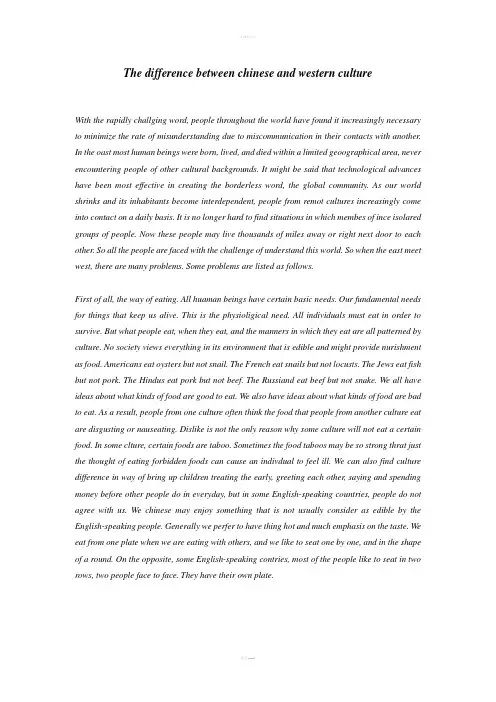
The difference between chinese and western cultureWith the rapidly challging word, people throughout the world have found it increasingly necessary to minimize the rate of misunderstanding due to miscommunication in their contacts with another. In the oast most human beings were born, lived, and died within a limited geoographical area, never encountering people of other cultural backgrounds. It might be said that technological advances have been most effective in creating the borderless word, the global community. As our world shrinks and its inhabitants become interdependent, people from remot cultures increasingly come into contact on a daily basis. It is no longer hard to find situations in which membes of ince isolared groups of people. Now these people may live thousands of miles away or right next door to each other. So all the people are faced with the challenge of understand this world. So when the east meet west, there are many problems. Some problems are listed as follows.First of all, the way of eating. All huaman beings have certain basic needs. Our fundamental needs for things that keep us alive. This is the physioligical need. All individuals must eat in order to survive. But what people eat, when they eat, and the manners in which they eat are all patterned by culture. No society views everything in its environment that is edible and might provide nurishment as food. Americans eat oysters but not snail. The French eat snails but not locusts. The Jews eat fish but not pork. The Hindus eat pork but not beef. The Russiand eat beef but not snake. We all have ideas about what kinds of food are good to eat. We also have ideas about what kinds of food are bad to eat. As a result, people from one culture often think the food that people from another culture eat are disgusting or nauseating. Dislike is not the only reason why some culture will not eat a certain food. In some clture, certain foods are taboo. Sometimes the food taboos may be so strong thrat just the thought of eating forbidden foods can cause an indivdual to feel ill. We can also find culture difference in way of bring up children treating the early, greeting each other, saying and spending money before other people do in everyday, but in some English-speaking countries, people do not agree with us. We chinese may enjoy something that is not usually consider as edible by the English-speaking people. Generally we perfer to have thing hot and much emphasis on the taste. We eat from one plate when we are eating with others, and we like to seat one by one, and in the shape of a round. On the opposite, some English-speaking contries, most of the people like to seat in two rows, two people face to face. They have their own plate.On the aspect of table manners, there are many differences between chinese and English-speaking people. For example, in some Englishi-speaking countries, Bread plates are to the left of the main plate, beverage glasses are to the right. Salad fork, knife and soup spoon are further from the main plate than the main course knife, fork and spoon. When eating bread rolls, break off a piece before buttering. Use the knife only to butter the bread, not to cut it. They should not start eating before your host does or instructs to do so. At larger meals, it is considered okay to start eating once others have been served. When finished, place the knife and fork together at five o’clock with the fork on the left. It is considered rude to answer the telephone at the table. If need to take an urgent call, excuse self and go outside. Try to eat all the food you are served. But in China, the table manners are different. Chinese traditionally eat rice from a small bowl held in the left hand. The rice bowl is raised to the mouth and the rice pushed into the mouth using the chopsticks. Some Chinese find it offensive to scoop rice from the bowl using a spoon. If rice is served on a plate, as is more common in the West, it is acceptable and more practical to eat it with a fork or spoon. The thumb must always be above the edge of the bowl. The host should always make sure the guests drinks are sufficiently full. One should not pour for ones self, but should offer to pour for a neighbor. When your drink is being poured, you should say "thank you" and tap fingers on the table to show appreciation. When people wish to clink drinks together in the form of a cheer, it is important to observe that younger members should clink the edge of their drink below the edge of an elder to show respect.Secondly, the way of communication. Form birth to death, communication plays an integral part in our life. There are some language problems, including the different styles of using language such as direct, indirect; expansive, succinct; argumentative, conciliatory; instrumental, harmonnizing; and so on. These different styles can lead to wrong interpretations of intent and evaluation of insincerity, aggreeiveness, deviousness, or arrogance, among other. The misinterpretation nonverbal signs and symbols such as gestures, postures, and other body movements. It is a definite communication barrier. But it is possible to learn the meanings of these observable message,usually in informal rather ways. It is more difficult to understand the less obvious unspoken codes of the other cultures.Language, as the carrier of cul ture, is created during the process of human beings’ productive labor and serves as the tool of communication to convey the message between people. However, it has been endowed with magic and power in particular language acts. As the old saying goes, troubles come out of the tongue. Superstitious people think that the language itself can bring about fortune or misfortune so that taboos to restrict the use of language are created. Anyone who violates them will get punishment, whereas those who faithfully obey the restrictions of language taboo will get protection. Furthermore, linguistic taboos change with the development of society .The paper firstly analyzes the evolution of linguistic taboo. It is indicated in the paper that linguistic taboo exists in almo st every aspect of people’s life and is a universal social phenomenon in China and Britain. Both Chinese and English cultures are in agreement about linguistic taboos such as pronunciation taboo, and vocabulary taboo. However, influenced by different cultural backgrounds, ideologies and the concepts of value, Chinese and English linguistic taboos also have differences, as is discussed in the paper from the aspects of taboo subjects, taboo numbers and names. At last, this paper puts forward two effective ways of avoiding taboo, that is, using euphemism and having a good knowledge of the taboo culture. And this discussion would help English learners improve their ability of cross-cultural communication and achieve better communicational effects. For example, During the feudal times, people were not equal to the rulers and were suppressed by their superiors. The distinction between the upper and the lower classes was also reflected in the evaluation of the language used by them respectively. The words of upper class used were considered good and elegant while those used by the lower class were regarded as vulgar and indecent and should be avoided in the speech of ladies and gentlemen. In modern society, as a result of the development of science and technology, many natural phenomena are no longer mysterious. Human beings not only constantly improve their abilities to exploit the world where they are living through their great wisdom and knowledge, but also make efforts to explore the extraterrestrial world. Science has much more say in today’s society. Thereby, the superstitious elements in linguistic taboos decrease while those reflecting spiritual civilization increase.In short, by comparison, we can find that both Chinese and English communication reflect peopl e’s psychology for good will, for safety and fortune and pleasantness. The Chinese and English people restrict their words and deeds through taboos, trying to keep a harmonious relationship between human and nature, or between people and society. They are a reflection of people’s pursuit of freedom and equality.The most important, the different way of family structure, family values and family education. Family structure is the big difference between east and west, traditional chinese, amony many other Asians, repect their elders and feel a deep sense of duty toward them. Children repay their parents` sacrifices by being successful and supporting them in old age. This is accepted as a natural part of life in China. In contrast, taking care of aged parents is often viewed as a tremendous burden in the English-speaking countries, where aging and family support are not honored highly. In some English-speaking countries are still extrmely family-oriented. They are dedicated to helping their children and will sacrifice greatly for their children to get an edcuation. In turn, the children are devoted to their parents, who often live nearby. Grown children who go away and leave the country for the economic reasons typically send large parts of their salary home to their parents and the rest of the family. Or in some Asia, any decisions or actions are done from family consideration, not individual desires. Peope`s behavior is judged on whether it brings shame or pride to the family. The children are trained to rely on their families, to honor elderly people, and to fear foreigners. And many of them think that their actions in this life will influence their status in the next life. The way of family edcation is also the different. We all know the family education is the elementary education for children. Many serious problems have appeared in our education system in recent years. Almost everyone has realized the importance of solving these problems and many people have presented a lot of valuable suggestions. There are many types of family education in the world and each of them shows distinctive features and is closely responsive to its culture. And American family education is the most famous one among them. There are great differences in the concepts of education, methods of education and results of education between East family education and West family education. In some English-speaking countries, parents’ aims are to train their children to have the ability of adapting to environmental variety and the ability of living independently. Based on this concept, most American parents emphasize more to train their children’s ability of independence once they are born. They generally believe that children’s growth must rely on their own experiences, because they think that children should form a self-supporting will and the capacity to live independently since their childhood. And the capacity comes from the training in the early age. The so-called training contains many aspects, such as work, temper will, patience, the spirit of hard work, etc. However, the most fundamental training is the ability of adapting to hard conditions. Through the process of work, children will form the labor sense, learn some work skills and form a habit of labor. Besides, children can learn how to overcome difficulties, temper their willpower, develop their talents and skills, rich their knowledge, and form a habit of hard work and thrifty by working in hard conditions. It is just in the unconsciously process that children will obtain the independent survivability and take the responsibilities for the society. Compared with someEnglish-speaking countries, Chinese parents have a very different concept of children’s education. Some parents inChina only care about whether the children have a promising future, a good job, a good life or not. Based on these expectations, the majority of parents feel that their responsibility for their children is to create as good conditions as possible they can so that the children will not worry about anything in the future. Chinese parents would like to provide everything what they can for their children in the process of children’s growth. In short, they would like to sacrifice anything if their children can live better with their help. Therefore, in the process o f children’s growth, the most important thing the parents concerning is to developing their children’s intellect, except for caring children’s daily life. In order to make their children have a good performance in study, become outstanding, or even become a famous person in the future, they would not let children do anything except studying. As for the children’s independence, civic awareness and their ability adapting to the society in the future, they consider little or not at all. From these aspects we can find the obvious differences of family education betweenAmerica and China.When we faced with those difference between West and East, we should give some advice to solve these problems. According to the three big difference that pointed, we should find some way to deal with these problems.We can study other languages and learn to expect in nonvwebal forms and other cultural aspects. We can train ourselves to meet intercultural encounters with more attention to situation details. We can use an investigative approach rather than stereotypes and preconceptions. We can gradually expose ourselves to differences so that they become less threatening. We can even learn to lower our tension level when needed to advoid triggering defensive reactions. The overall goal should be to achieve intercultural communication competence.So the ideal solution to reduce the problems are to share knowledge with others in communication. This is why it is easiest to communicate with other members of the same group. This is why people so often gather together socially with others who are very much like them. Since intercultural communication is communication with members of different cultual groups, and therefore, because we do not share knowledge, assumptions, values, and forms of discourse with them, we must expect there to be problems of interpretation. We must look for these problems, anticipate where they will arise out of our differences, and then plan our aommunications to be as effective as possible. However, we have to remember that, most of the time, the different ways that are the customs of dfferent cultures are neither right nor wrong. It is simply that different people do the same tings in different manners, even though we can not understand ,we should show the respect. I believe this is the best way to make our life become more comfortable and make the world more harmonious.. ..。
中西方爱情诗差异

目 录
• 中西方爱情诗的文化背景 • 中西方爱情诗的主题与风格 • 中西方爱情诗的情感表达 • 中西方爱情诗的意象与象征 • 中西方爱情诗的创作技巧与手法 • 中西方爱情诗的影响与启示
01
CATALOGUE
中西方爱情诗的文化背景
文化起源
01
西方爱情诗源于古希腊罗马神话 和基督教文化,强调个人情感和 性爱自由。
。
人物形象
要点一
总结词
中西方爱情诗中的人物形象存在较大差异,中国诗中常出 现的是柔弱、婉约的女性形象,而西方诗中则常出现的是 热情奔放、追求自由的爱情追求者形象。
要点二
详细描述
在中国爱情诗中,女性形象通常被描绘为柔弱、婉约、含 蓄的,如“玉人”、“淑女”、“红颜”等,这些形象体 现了中国传统文化中对女性的审美标准和道德要求。而在 西方爱情诗中,人物形象通常更加鲜明和个性化,强调对 爱情的追求和自由的向往,如拜伦、雪莱等诗人笔下的女 性形象。
促进了跨文化交流,加深了东西方文化的相互理解。
对跨文化交流的启示
01
对共同点的认识
02 中西方爱情诗都表达了对真爱的追求和对美好生 活的向往。
03 爱情是人类共同的情感体验,不受地域和文化的 限制。
对跨文化交流的启示
• 爱情诗是情感交流的重要载体, 有助于增进人与人之间的情感共 鸣。
对跨文化交流的启示
浪漫
西方爱情诗则更倾向于浪漫主义的表达方式,强调情 感的纯粹和美好,追求心灵的契合和精神的满足。
04
CATALOGUE
中西方爱情诗的意象与象征
自然景物
总结词
中西方爱情诗中,自然景物常常作为象征和 隐喻,表达诗人对爱情的感受和思考。
从诗歌《西风颂》中看到的中英跨文化差异与交流
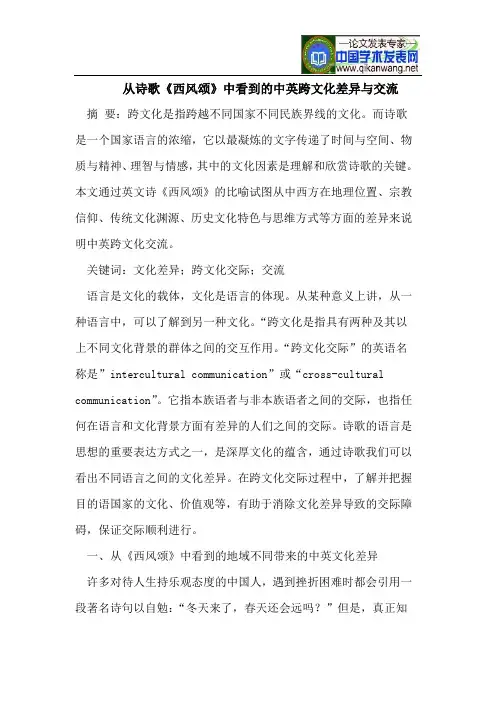
从诗歌《西风颂》中看到的中英跨文化差异与交流摘要:跨文化是指跨越不同国家不同民族界线的文化。
而诗歌是一个国家语言的浓缩,它以最凝炼的文字传递了时间与空间、物质与精神、理智与情感,其中的文化因素是理解和欣赏诗歌的关键。
本文通过英文诗《西风颂》的比喻试图从中西方在地理位置、宗教信仰、传统文化渊源、历史文化特色与思维方式等方面的差异来说明中英跨文化交流。
关键词:文化差异;跨文化交际;交流语言是文化的载体,文化是语言的体现。
从某种意义上讲,从一种语言中,可以了解到另一种文化。
“跨文化是指具有两种及其以上不同文化背景的群体之间的交互作用。
“跨文化交际”的英语名称是”intercultural communication”或“cross-cultural communication”。
它指本族语者与非本族语者之间的交际,也指任何在语言和文化背景方面有差异的人们之间的交际。
诗歌的语言是思想的重要表达方式之一,是深厚文化的蕴含,通过诗歌我们可以看出不同语言之间的文化差异。
在跨文化交际过程中,了解并把握目的语国家的文化、价值观等,有助于消除文化差异导致的交际障碍,保证交际顺利进行。
一、从《西风颂》中看到的地域不同带来的中英文化差异许多对待人生持乐观态度的中国人,遇到挫折困难时都会引用一段著名诗句以自勉:“冬天来了,春天还会远吗?”但是,真正知道它出自英国诗人雪莱的《西风颂》(ode to the west wind)的人,估计就不多了;而通过雪莱了解到英国人眼中的西风像什么样子,从而明白他们为什么歌颂西风的人,也许就更少。
不同的民族所处的不同地理位置也给表示自然环境的词汇带来了不同的文化内涵。
由于所处的地域不同,相应地就有不同的自然条件和地理环境。
地理环境的不同会引起文化上的个性和差异,形成一些独特的文化概念。
这些文化差异都在诗歌语言中体现出来,对英汉翻译产生一定的影响。
例如,中国东临大海,西部为高山,所以在中国,“东风”是“春天的风”,“西风”却是凛冽的。
中西诗歌比较
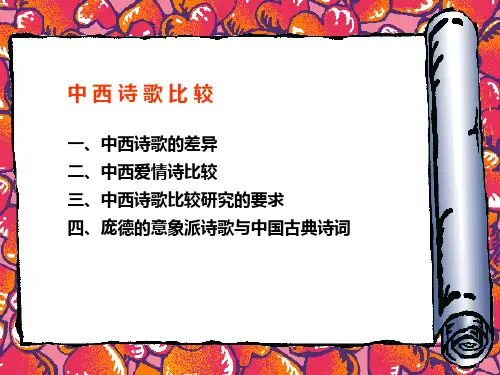
像云雀喜爱 凌空高唱, 像朝花喜爱 天香芬芳, 我这样爱你,
热血沸腾, 你给我勇气、 喜悦、青春, 使我唱新歌, 翩翩
起舞, 愿你永爱我, 永远幸福!”
(歌德《五月之歌》)
“我的爱人像一朵红红的玫瑰 ,四月里迎风初开。 我的爱人像一首甜甜的曲子 ,奏得又合拍又和谐”
(罗伯特·彭斯《一朵红红的玫 瑰》 )
由于语法不同,中西诗歌也形成不同特点。 如汉字的字形没有时态、语态、性数的变化,所以也 不必在诗歌中象英诗那样要有主语、谓语、冠词、连 接词等,且诗中的词还可以倒置,可以改换词性。
杜甫《春望》“国破山河在,城春草木深。感时 花溅泪,恨别鸟惊心。烽火连三月,家书抵万金。白 头搔更短,挥欲不胜簪。”
中国抒情诗的这一特点正是现代不少西方诗人努 力掌握但又难以做到的。如,“漂泊如云”四字的景 象,华兹华斯也得写成“I wandered lonely as a cloud .”
忽见陌头杨柳色,悔教夫婿觅封侯。《闺怨》(无名氏)
何时倚虚幌,双照泪痕干?
《月夜》(杜甫)
蜡烛有心还惜别,替人垂泪到天明。《赠别》(杜牧)
《燕歌行》
秋风萧瑟天气凉, 草木摇落露为霜, 群燕辞归雁南翔, 念君客游多思肠。 慊慊思归恋故乡, 君何淹留寄他方? 贱妾茕茕守空房, 忧来思君不敢忘, 不觉泪下沾衣裳。 援琴鸣弦发清商, 短歌微吟不能长。 明月皎皎照我床, 星汉西流夜未央。 牵牛织女遥相望, 尔独何辜限河梁。
“名声——我对你若有兴趣,并不是爱听你响亮的吹
嘘;是为要看她灼灼的目光——她也懂得了:我并非
配不上她!”
(拜伦)
“一个是不再爱,一个是不再被爱,这都是难以忍受 的死亡,至于冥目咽气,倒没有什么。”(伏尔泰)
“爱情激荡着活跃的情绪,它可以使死亡的人复活, 它可以使沙漠有人居住,它可以使爱的人幻影重现。”
中西方诗歌文化差异
东西方诗歌文化差异会计学院Z10061143100603侯文君东西方诗歌文化差异摘要:诗歌作为一种自我表达和表现诗人对世界的诗性理解, 在形式上分行 排列,并具有一定的节奏韵律的文体,在各种文体中出现的最早,主要有叙事诗 和抒情诗。
限于课时的有限,这里只讨论中西抒情诗的异同。
关键词:诗歌,中西方,音节,抒情一、 中西抒情诗的产生及传统。
中西抒情诗的产生都是个人意识增强的结果。
但其中的个人意识有所不同。
西方古代抒情诗要求抒发个人主观的思想情感; 中 国古代抒情诗总是把个人价值蕴含于社会价值之中,即“小我”之中有“大我” 0二、 中西诗歌情趣。
中西方诗个的不同品格,主要源于社会文化的差异。
中国文化建立在儒道的基础上。
儒家重人事、伦理教化,内圣外王,修身齐 家治国平天下,追求人与人、人与社会的和谐、成为儒家的最高理想。
这使中国 诗歌亦强调诗的教化作用、使用价值。
而追求人的精神超脱、回归自然的道家, 归根结底仍是偏重人事 老子老于世故,庄子的超越精神走向的亦是齐生死、 泯物我、一是非,而不是西方式的宗教世界。
因而,对于中国诗人来说,他们不 满现实之余,在寻求解脱之时,自然往往成为他们唯一的皈依,因而,中国诗人 很少离开人事去穷尽宇宙的本源、精神的本质。
希腊文化和基督教精神,使西方 文化一方面重感情、重现世享乐,另一方面又具有一种彼岸超越意识。
这使得西 方诗歌一方面在大力弘扬英雄主义、 现实关注中又常常保持一种超越精神, 寻求的宗教精神时时贯穿于诗歌之中,使不少诗歌往往有一个主宰宇宙的神明高 居其上或蕴含其中。
从《荷马史诗》、《神曲》、《浮士德》、华兹华斯、拜伦、雪 雨果到艾略、叶芝、瓦雷拉……莫不如此。
中西方不同的文化背景,导致中国诗人更多致力于人与社会现实伦理的沟 人与自然的默契;西方诗人则更偏重于揭示人与自我、人与神的关系。
鉴于 下面仅就爱情与自然两大主题,探讨中西抒情诗的差异。
(一)、爱情抒情诗个人主义精神,渲染人之常情,另一方面在 寻求人的终极拯救,因而代表终极价值的 莱、 通, 此,中西爱情诗都历史悠久,但情趣各异。
从英汉对比的角度赏析诗歌翻译
从英汉对比的角度赏析诗歌翻译诗歌堪称中国文化的一朵奇葩,唐代诗人李白以豪放不羁的文笔蜚声中外,其很多作品都是家喻户晓的经典之作,其中《望庐山瀑布》更是被称作七言绝句之首。
有不少学者将这首诗翻译成英文介绍给西方读者。
本文从诗歌的可译性出发,着重从内容、形式和风格三个方面对《望庐山瀑布》的几个英译本进行比较分析,进而探讨汉英两种语言的差异和中西文化的差异。
标签:《望庐山瀑布》诗歌可译性汉英语言差异中国古典诗歌文字隽永,意境深远,与其它文学作品如小说、散文等相比文字简练,内容含蓄,有人称赞其为“空中之音,相中之色,水中之月,镜中之象”。
李白的诗歌更是如此,在中国甚至世界文学上都享有很高的声誉。
基于此,各种语言版本的李白诗歌便一一呈现在读者面前,尤其是英译本引起了学者广泛关注。
但是,要从内容、形式和风格等方面把李白诗歌豪放不羁的意境英译出来,难度不容小觑。
笔者认为,在翻译诗歌时译者的任务就是进行“移植”,即用另一种语言把诗歌的神韵翻译出来,让其在不同文化背景下生根发芽。
本文以著名学者许渊冲、王守义&John Knoepfle(以下简称为王诺合译)的两个英译本为例,从英汉对比的角度进行研究,并从原诗和译诗的内容、形式和风格三个方面来分析英汉两种语言的差异及其对翻译的影响。
一、内容差异翻译就是一种语言忠实地再现另一种语言所表达的内容、思想和感情。
而内容即指作品所叙述的事实、说明的事理、描写的景物以及文字的叙述,在说明和描写之中反映作者思想、观点、立场、所流露的感情等。
译诗应首先忠于原作,译出作品的内容应与原作的思想内容保持一致。
在翻译诗歌作品时,刘重德认为我们应做到:“信于内容,达如其分,切合风格(信达切)。
”[1]刘认为在这三者中,“信于内容”应排在第一位。
著名学者许渊冲也认为:“翻译唐诗要尽可能传达原诗的‘意美’‘音美’和‘形美’。
……最重要的是‘意美’,其次是‘音美’,再次是‘形美’”[2]分别由许渊冲与王诺合译的《望庐山瀑布》的两个英译本都较好地展现了原诗的内容。
中西爱情诗歌比较
中西爱情诗歌比较爱情是人类永恒的主题,诗歌是表达爱情的最佳方式之一。
中西方文化的不同背景,也使得中西爱情诗歌在表达方式上存在一些差异。
本文将从风格、主题和形式三个方面,对中西爱情诗歌进行比较。
一、风格比较中西爱情诗歌在风格上存在明显的差异。
从诗歌的表达方式来看,中文诗歌倾向于以抒情为主,通过描写情感、表达心声来表达爱情;而西方爱情诗歌更注重形容词形容等修辞手法,以绘画般的描述来表达爱情。
例如,李白的《静夜思》以婉约抒情的方式表达了思念之情:“床前明月光,疑是地上霜。
举头望明月,低头思故乡。
”而西方诗人雪莱的《爱的抱枕》则通过比喻手法细腻地描绘了爱情的美妙:“我爱你的我的个体,我爱你的灵魂不变。
”二、主题比较中西爱情诗歌的主题有相似之处,也有不同之处。
中文诗歌更多地将爱情与自然、季节等元素相融合,表现出深情厚意的爱情。
李煜的《浪淘沙令》通过描写自然景色来表达对爱情的思念:“夜久犹为报,钟山何处响。
客心自有主,凭谁看落晖。
”而西方爱情诗歌更注重揭示内心情感和矛盾,对于爱情的探索和思考更加深入。
例如,英国诗人拜伦的《谢尔盖娅的回忆》通过描写一段短暂而绝望的爱情,表达了对失去爱人的痛苦和悔恨:“我伫立在你的昔日宴会厅,回忆起我的错误,心都碎了。
”三、形式比较中西爱情诗歌在形式上也存在一些差异。
中文诗歌在形式上较为自由,常采用律诗、绝句等传统形式,并注重音韵的工整和平仄的控制。
李商隐的《锦瑟》用辞华丽,声调优美:“锦瑟无端五十弦,一弦一柱思华年。
庄生晓梦迷蝴蝶,望帝春心托杜鹃。
”而西方爱情诗歌则更灵活多样,没有固定的形式限制,可以运用自由诗、散文诗等形式。
例如,美国诗人金斯伯格的《爱之歌》采用散文诗的形式,赋予爱情以真实而感人的力量:“我爱你,就像一只小鸟爱阳光。
我不能没有你,就像花朵不能没有雨露。
”综上所述,中西爱情诗歌在风格、主题和形式上存在一定差异。
中文爱情诗歌注重抒情,将爱情与自然融为一体,表达深情厚意;而西方爱情诗歌更注重形容和描述,强调内心情感的矛盾与探索。
中英诗歌对比赏析·中西文化差异20页文档
谢谢你的阅读
❖ 知识就是财富 ❖ 丰富你的人生
71、既然我已经踏上这条道路,那么,任何东西都不应妨碍我沿着这条路走下去。——康德 72、家庭成为快乐的种子在外也不致成为障碍物但在旅行之际却是夜间的伴侣。——西塞罗 73、坚持意志伟大的事业需要始终不渝的精神。——伏尔泰 74、路漫漫其修道远,吾将上下而求索。——屈原 75、内外相应,言行相称。——韩非
中英诗歌对比赏பைடு நூலகம்·中西文化差异
16、自己选择的路、跪着也要把它走 完。 17、一般情况下)不想三年以后的事, 只想现 在的事 。现在 有成就 ,以后 才能更 辉煌。
18、敢于向黑暗宣战的人,心里必须 充满光 明。 19、学习的关键--重复。
20、懦弱的人只会裹足不前,莽撞的 人只能 引为烧 身,只 有真正 勇敢的 人才能 所向披 靡。
